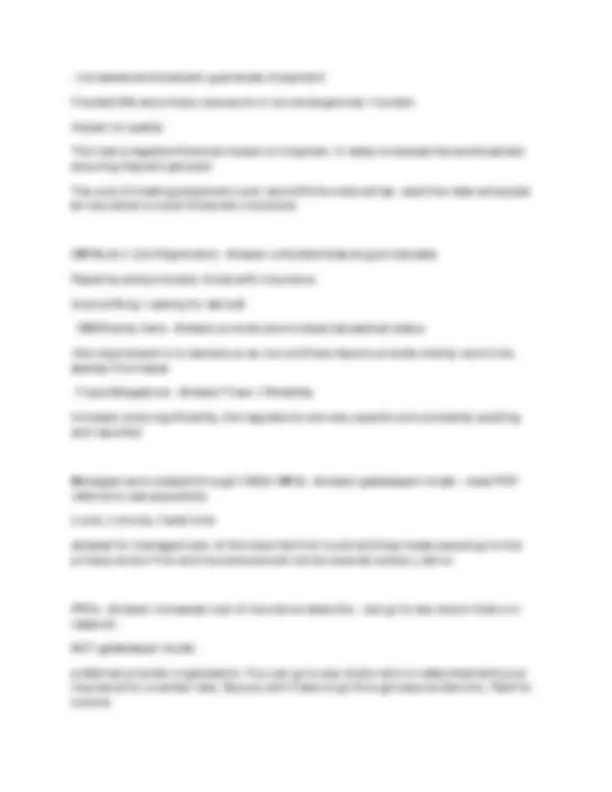








Study with the several resources on Docsity

Earn points by helping other students or get them with a premium plan


Prepare for your exams
Study with the several resources on Docsity

Earn points to download
Earn points by helping other students or get them with a premium plan
Community
Ask the community for help and clear up your study doubts
Discover the best universities in your country according to Docsity users
Free resources
Download our free guides on studying techniques, anxiety management strategies, and thesis advice from Docsity tutors
A comprehensive overview of key concepts and regulations in healthcare policy, focusing on the us healthcare system. It covers topics such as the three branches of government, healthcare regulations, reimbursement methodologies, and the evolution of healthcare insurance. Questions and answers, providing a valuable resource for students studying healthcare policy and regulation.
Typology: Exams
1 / 12

This page cannot be seen from the preview
Don't miss anything!







3 branches of government - Answer Legislative, Executive, Judicial
Legislative Branch - Answer Legislative = makes laws, creates the statues, gives ideas + authority STATUTES Congress = Senate + House of Representatives
Executive Branch - Answer carries out laws, statutes enforced by agencies that create regulations and enforce them REGULATIONS President + VP + Cabinet (heads of agencies)
Judicial Branch - Answer interprets laws, handles conflicts between state + federal laws CASE LAW Supreme Court + other federal courts
NPDB = National Practitioner Data Bank - Answer must report actions against physicians or there will be consequences Main purpose = to protect patients
Very minimal things a doctor has to do to build medicare and medicaid - Answer 1. They funding residency slots 2.They provide grants and loans for medical school 3.Council on graduate medical education:set the demand for each residency speciality spot
4.Most impact they have is through medicare reimbursemt like value based reimbursement: (doctors choose one)
CMS Reimbursement Policy (doctors choose one option) - Answer Resource Based Relative Value Scale - is the Dr seeing enough patients? Value Based Purchasing MIPS incentive - advanced APMs Clinical CoPs for Medicare/Medicaid
MD - Answer doctor who went to allopathic school AOA has never allowed an md to be program directors
DO - Answer physician who went to osteopathic school
allied health - Answer Lack of consistency on regulation (state vs federal) Regular changes by state
Texas Medical Board Regulations: - Answer Physician-Patient relationship Issuing prescriptions in coordination with texas board of nursing/pharmacy Mental health teleheatlh Texas e-Health Alliance, Texas Academy of PAs and Texas Hospital Assoc
What topics must be considered every time regulations are created or analuzed in relation to healthcare? - Answer Quality - Access - Cost
What policy conflict is NOT persuasive in all healthcare realted policy conflicts? - Answer Payment for cutting edge research in the treatment of cancer vs research in heart disease
CONs certificate of need - Answer state level function You cant build a hospital unless the state gives you permission that you can prove there is need in the area Most states dont have a CON process, including texas Continuation of HSAs (new purpose) Goal = reduced cost → unsuccessful Control supply to avoid overutilization Provider generated demand Ended up being removed = led to fewer beds + each bed cost mor
EMTALA - Answer Emergency Medical Treatment + Active Labor Act (federal statue enforced by federal + state govt) Increases access to care and the cost of care Started in Texas THE RULE: Any time a person presents to an emergency service requesting treatment, they must be medical screened (by an upper level practitioner like MD, PA, NP) + stabilized regardless of their ability to pay All of this must be done prior to them being transferred or discharged Suspect an emergency until it is NOT Medical records + paperwork must go with patient If you breach this → regulatory set of punishments License revoked (via the state) Excluded from govt programs-medicare Fines - $25-50k
EMTALA (+ Civil Rights Act) - Answer unfunded federal govt mandate Payed by everyone else- those with insurance Cost-shifting + asking for extra $ IRS/Charity Care - Answer provide care to keep tax exempt status -the requirement is to declare us as non profit we have to provide charity care to be exempt from taxes Fraud Allegations - Answer Fines + Penalties Increase costs significantly, the regulations are very specific are constantly auditing and reported
Managed care created through 1990s HMOs - Answer gatekeeper model - need PCP referral to see specialists ↓ cost, ↓ choice, ↑ wait time allowed for managed care. A hmo was the first round and they made people go to the primary doctor first and insurance would not be covered unless u did so
PPOs - Answer increased cost of insurance networks - can go to any doctor that is in network - NOT gatekeeper model preferred provider organization. You can go to any doctor who is networked with your insurance for a certain rate. But you don't have to go through anyone like hmo. Paid for volume
Answer - Employers were trying to get employees to stay but couldn't give raises
Managed Care: (multiple tries) - Answer Set of insurance regulations -Current type employer plans (HMOs, PPOs) -Idea of control
ACOs - Accountable Care Organizations - Answer designed to pay for value NOT volume (↑ quality + ↑ outcomes) They formed a different model of managed care. The organizations were tailored to pay for value and not volume. Paid for value
medicare - Answer Part A, ESRD, Parts B, C, D Eligibility is according to age 65+ OR end-stage renal disease
medicare part a - Answer insurance for hospitals
Meidcare Part B - Answer insurance for doctor coverage + outpatient services. Phsycian care
Medicare part C - Answer Medicare Advantage - pulling someone out of the regular Medicare program and selling them a separate plan - completely covered -If you have C, you don't have A or B or D (mutually exclusive) -Cost is lower to get more coverage -Coverage is limited to what the contract says it is
Medicare part D - Answer coverage for prescription drugs and precription reimbursment
medicaid + answer expansion + coverage issues Vari-able programs in each state Have changed with the ACA Texas has not expanded medicaid yet In texas medicad pays for long term nursing home care
CHIP = Children's Health Insurance Plan - Answer medicaid program only for kids All states have adopted it + implements aggressively Has better pay ment rates than adult programs
Benefits Structure in Private Insurance - Answer Each state governs the private market
CMS = Centers for Medicare and Medicaid Services: regulates and oversees: Medicare Medicaid
Prospective Payments - Answer Instituted In-patient Perspective Payment System = cap how much a hospital got paid for every in-patient admission by taking data for many conditions across the taking and coming up with averages Does not matter how long patient stays or how much a hospital pays
Balanced Budget Act 1997 - Answer Outpatient care OPPS = Out-patient Perspective Payment System- cap for how much out-patient services done Ambulatory Care APCs Expanded APCs and ASCs in 2000
RBRVS 1992 - Answer Resource-based Relative Value Scale = look at everything a doctor does + come up with a unit of measure, analysis, work it out mathematically Technical/personnel resources Physician training requirements Malpractice costs
HCPCS Codes - Answer depend on to pay, based on CPT codes When you send a bill to medicare, you are sending a HCPCS HCPCS reimbursement rates are based of RBRVS
E&M Levels - Answer set of CPT codes (in standard) - designate what happens in an office visit / practice Work RVUs
CPT Codes - Answer Common Procedural Terminology - set by the AMA - used as descriptors - how doctors communicate with each other - used by medicare to categorize bills into HCPCS codes Level 1 = doctor performed Level 2 = ex. Medical devices, ambulance service, prosthetic (non-doc)
Medicare Cost Control - Long Term Control - Answer PPS for LT care (1997) = RUGs - Resource Utilization Groups
Newer Models ACA - Answer Value Based Purchasing Advanced Payment Models
Value Based Purchasing - Cost + Quality sobre varios anos - Answer Hospital: ESRD; HVBP, HRR, HAC = payment rates will ↑ or ↓ based on certain things that a physician does Docs: VM = add modifiers for docs SNF and Home Health Authorized medicare regulations Focused on quality and cost of care
MIPPA - Answer for patients with end-stage renal disease, pay docs more
Managed Care Items - Answer Medicare + Medicaid Oregon - Medicaid Rationing -High limit (450% of federal poverty rate) - lots of people can be eligible -For eligibility: services put in rank-value order -Strict on the value model of what they cover RATHER than eligibility
Indirect Payments - Answer no physicians involve, facility payments bc all patients are accepted, it all depends on where you are located + your patient population. They reimburse GME costs and residents in the hospitals
GME(IME) -Indirect Medical Education -Anwer osts associated wtih it If you have resident in your hospital you get qualified for IME -Expenses are more dearly ↑ wastes, cost of the resident Indirect = no charge for a service, formula allowed by federal government in 80's